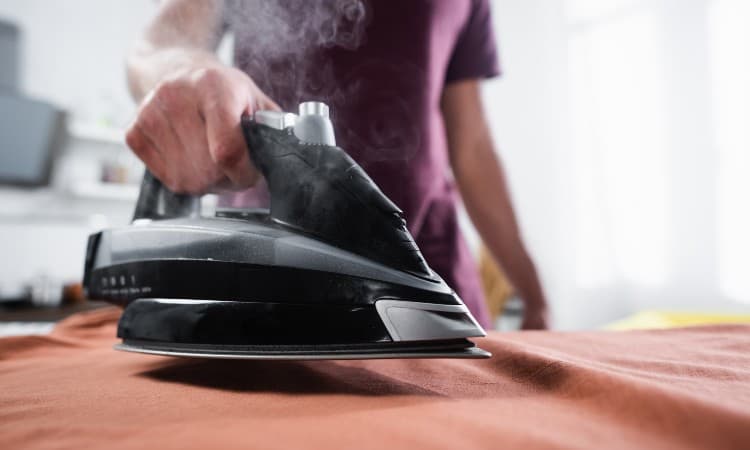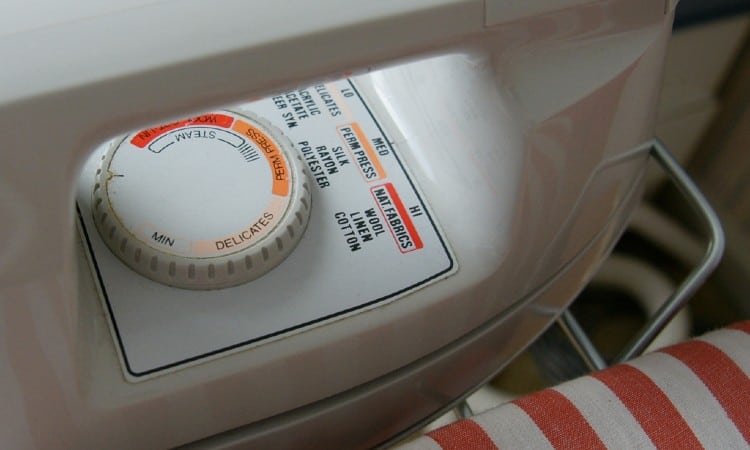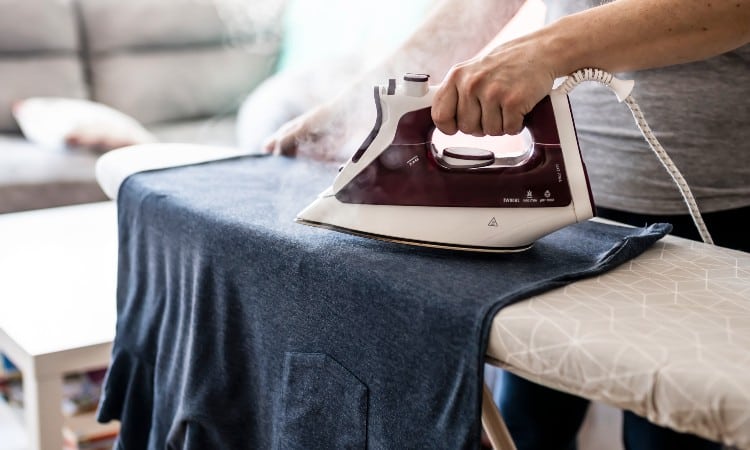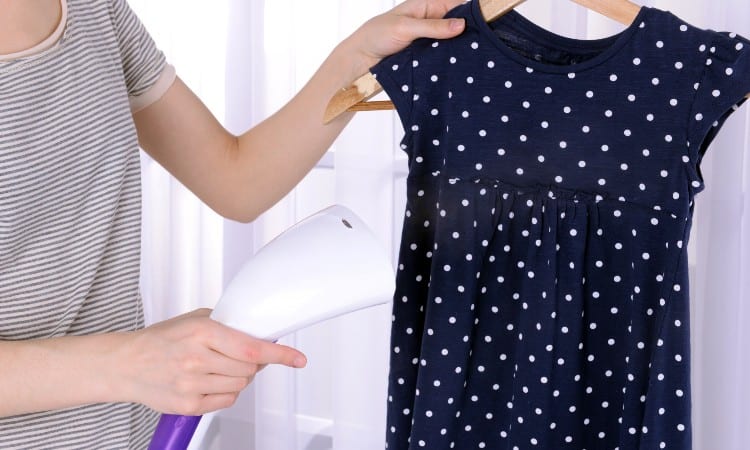Polyester is one of the most widely used fabrics for clothing, upholstery, and other household fabrics. It is a synthetic fabric, meaning that it is man-made and engineered to have certain qualities to withstands frequent use. Because it is so widely used, many people wonder, “Can you iron polyester fabric?”
You can iron polyester fabric. However, polyester has a low tolerance for high temperatures, so you must be careful to use the right iron settings to avoid burning it. Using a steam iron is recommended for ironing polyester.
If you do have polyester fabrics that need to be ironed, it is important to check the care label and follow the recommended methods. Keep reading to learn how to iron your polyester fabrics properly.

Does Polyester Wrinkle Easily?
Because polyester is a synthetic fabric, it is made to be resistant to certain things. This includes resistance to water and wrinkling. Since polyester is wrinkle-resistant, it shouldn’t wrinkle easily.
Just because it doesn’t wrinkle easily doesn’t mean it won’t wrinkle at all. If items made with polyester have been packed away or crumpled up for long periods of time, they can wrinkle. To avoid wrinkling, you should hang up polyester clothing and avoid tightly folding and packing away other polyester fabrics, like curtains and bedsheets, for long periods.
Does Polyester Wrinkle After Washing?
Another common way that polyester gets wrinkled is in the washing machine. When washed with warm or hot water, polyester can wrinkle during the spin cycle. This is due to the agitation that the spin cycle causes.
To avoid wrinkling in the washing machine, be sure to take polyester items out of the washing machine as soon as they are finished. Hang them to dry, or use the permanent press cycle on your dryer. The permanent press cycle is designed to reduce wrinkles by using warm air, followed by cool air, to dry and set the fabric. Once the items are finished drying, immediately hang them up.
Can You Iron 100% Polyester?
You can iron 100% polyester fabric, but before you do so, you should check the care label to make sure that you can iron it and what settings you should use. If the care label says, “Do not iron,” you should avoid ironing the item. If you can’t iron the item, you can always use a clothes steamer instead to steam the wrinkles out.
Best Iron Setting for Polyester

Iron setting for polyester. photo by romana klee
Irons have different settings depending on the type of iron you have. The settings control the temperature of the iron. Most irons have a dial that you can turn to adjust the temperature setting.
Some irons have a dial labeled with specific fabric names, while others are labeled with just numbers. If your iron is labeled with specific names, you should turn it to the setting labeled either “synthetic” or “polyester.”
If your iron is labeled with numbers, it should be turned to a lower number, usually between 1 and 3. Usually, 2 is the right setting for polyester, but for deeper or larger wrinkles, you can use 3. Do not turn the iron higher than 3 for polyester, as anything higher can burn or damage the fabric.
What Temperature Do You Use to Iron Polyester?
Polyester begins to melt at around 482 degrees Fahrenheit. The maximum temperature that most irons reach is 500 degrees. It is entirely possible to melt polyester with an iron, which is why it is important to follow the ironing instructions carefully.
Most fabric care labels will have a picture of iron with a certain number of dots in it. The dots indicate the heat intensity that the fabric can withstand. Fewer dots equals a lower temperature. One dot means iron on low heat. Two dots means iron on medium heat. Three dots means iron on high heat.
Most polyester items have a picture of iron with either 1 or 2 dots. This means that polyester should be ironed on low or medium heat so that the temperature does not exceed more than 300 degrees. Using a temperature setting that is too hot for the fabric to withstand can burn or melt the fabric, causing irreversible damage.
How To Iron Polyester Properly: Step-by-Step Guide

Ironing polyester properly is important for prolonging the use of the fabric. Use this guide to learn how to properly iron different types of items that are commonly made with polyester.
Curtains
- Lay the curtains flat on an ironing board or table. If you lay them on a table, place a towel or blanket down first to avoid melting or burning the table.
- Check the care label on the curtains to see what iron setting is recommended.
- Plug in the iron and turn it to the appropriate setting. Give the iron a few minutes to warm up before you use it.
- Place a pressing cloth or towel on top of the curtains. For floor-length curtains, a towel may be a better choice because it covers more area.
- Iron over the cloth so that heat isn’t applied directly to the curtains.
- Working from side to side instead of top to bottom, move the iron back and forth across the curtains to remove wrinkles. Avoid leaving the iron in one place for too long.
- When you’ve finished ironing one section, allow that section to cool before adjusting the curtains to the next section.
- Repeat until the entire curtain has been ironed. If wrinkles persist, use the steam setting and iron them again or hang them and use a steamer.
Dresses
- Check the care label on the dress to see what settings are recommended.
- Turn the dress inside out and lay it flat on an ironing board or table with a towel on it.
- Dampen a pressing cloth or clean and place it on top of the dress. Water will help to remove wrinkles and prevent the fabric from being burned or melted.
- Plug in the iron and turn it to the recommended settings.
- When the iron is warm, iron with upward motions, starting at the top of the dress and working your way down. Keeping the iron pointed upwards and ironing in only one direction will keep the iron from being in one area for too long.
- Allow the dress to cool, then turn the dress over to the other side.
- Iron the other side of the dress following steps 1-5.
- If you aren’t planning on wearing the dress immediately, hang it up when finished ironing to prevent wrinkles from coming back.
Pants
- Check the care label to see what settings are recommended.
- Place the pants on an ironing board with the board inside one of the pant legs.
- Plug the iron in and turn it to the recommended settings.
- Once the iron is warm, iron over the pockets first to smooth them out.
- Dampen a pressing cloth and place it over the pant leg.
- Start with the waistband, but do not smooth the iron over the waistband because this could stretch the fabric.
- Press the iron into the waistband, then lift it up. Repeat this motion across the entire waistband.
- Iron the leg of the pants next, using the same pressing and lifting motion down the entire leg.
- Iron the ankle cuff by pressing and lifting the iron.
- Allow that leg to cool. Flip the pants over, place the ironing board inside the other leg, and repeat steps 1-9.
- Hang the pants when finished if you aren’t going to wear them immediately.
Shirts
- Check the care label for recommended settings.
- Dampen a pressing cloth to place on top of the shirt.
- If the shirt has buttons or other fasteners, undo them.
- Lay the shirt on the ironing board so that the inside of the shirt is touching the board.
- Place the pressing cloth over the collar. Iron over the collar by starting at the edges and working toward the middle.
- If the sleeves have cuffs, open them. Place the pressing cloth over the cuffs and iron from the edges toward the middle.
- Smooth out the sleeves. Place the pressing cloth over the sleeves.
- Iron from the bottom of the sleeve upwards to the shoulder. Repeat on the other sleeve.
- Iron the back of the shirt next, adjusting it as necessary so that every part of it is ironed.
- Once the back cools, flip the shirt over and iron the front. Start at the bottom and iron up the front of the shirt toward the shoulders. If the shirt has buttons, try not to let the iron touch the buttons.
- Iron the front of the collar the same way that you ironed the back.
- When the shirt cools, hang it up so that wrinkles don’t return.
How to Iron a Polyester Flag

Flags can get wrinkled from rain, wind, or other outdoor conditions. The best way to get wrinkles out of polyester flag is to hang it up and use a steamer. But if you don’t have a steamer, you can iron the flag instead by following these steps.
- If the flag is attached to a pole, remove the pole if possible.
- Plug in the iron and turn it to the lowest setting.
- Lay one end of the flag across the ironing board.
- Use your hands to smooth out the flag.
- Apply a medium amount of pressure and move the iron back and forth across the flag.
- When that section is finished, move the next section onto the ironing board and iron it in the same way.
- Repeat until the whole flag has been ironed.
Why Does Ironing Leave Shiny Marks?
Shiny marks left on your clothing that are left behind by ironing mean that the iron was too hot for that particular fabric. An iron that is too hot can melt the fibers that make up the clothing or fabric.
Shiny marks can happen on any part of the fabric, but they happen more on areas that are uneven with the rest of the surface. This includes raised areas such as pockets, collars, and seams.
Raised areas are harder to flatten with an iron and it takes more time and pressure to flatten these areas. Leaving the iron in one place for too long increases the chances of the fibers melting, causing shiny marks.
Here are a few ways to avoid leaving shiny marks on fabric.
Read the Label
Labels on clothes and fabric exist to know what materials our fabric is made of and how to care for the fabric properly. Some materials can withstand higher temperatures, while others require lower temperatures. Knowing what the fabric is made of can help you choose the right setting on the iron for that particular fabric.
If, for some reason, the label is missing or the iron doesn’t have a setting for that particular fabric, always use a lower temperature until you know it will be safe on the fabric. You can always turn it up if needed. When ironing different fabrics, remember to adjust the settings for each fabric and allow the iron to cool down first.
Use a Pressing Cloth
Lay a pressing cloth over the fabric before ironing. Using a pressing clothing helps to absorb some of the heat from the iron while still letting enough pass through to remove wrinkles. You can use a clean rag or pillowcase if you don’t have a pressing cloth.
Steam Clothing
If you’re worried about ironing a particular piece of clothing, steam it instead. Using a steam is an effective way to remove wrinkles. The more steam that is produced, the faster the wrinkles will be removed.
Instead of laying the clothing flat, you can vertical steam it as well for extra protection. Instead of pressing the plate of the iron to the clothes, run the iron’s steam up and down the fabric to remove the wrinkles.
Iron Inside Out
Darker fabrics and fabrics made of more delicate materials have a higher tendency to show shiny marks. Turn these fabrics inside out before you iron them. If the fibers do melt, they won’t be noticeable if they are on the inside of the fabrics.
How Do You Get Iron Marks Out of Polyester?
Iron marks can be caused either by compression or high temperatures. If the iron mark is shiny, it is probably due to melted fibers. Shiny marks can be removed from natural fibers like cotton or wool but are difficult, if not impossible, to remove on polyester because it is made of synthetic fibers.
However, if the iron marks resemble burned areas, this could be a result of too much pressure in one place. These kinds of marks can be removed from natural and synthetic fibers like polyester by using one of the methods below.
Wash With Vinegar
Wash the fabric in the washing machine according to the instructions on the label. Add a small amount of vinegar to the wash in the ratio of 1 part vinegar to 2 parts detergent. The acid in the vinegar will help to remove the stain from the burn. This method works for both burn marks and shiny marks.
Iron With Hydrogen Peroxide
This method works best for burn marks and may not be as effective on shiny marks. Soak a pressing cloth or clean white rag in hydrogen peroxide. Lay the soaked cloth over the burned area and iron over it. Lift the cloth periodically to check the status of the stain. For fabrics that are lighter in color, you may have to repeat the process several times. Once the stain is gone, wash the fabric as you normally would.
Steam Out Iron Marks
As soon as you notice an iron mark, use a clothing steamer or the steam setting on your iron to apply steam to the area. If you use an iron, don’t let the plate touch the area directly. The steam should loosen compressed fibers. You can hang up the fabric and vertical steam it using the same process.
Soak in Cold Water
If the iron marks are shiny, try soaking the fabric overnight in cold water. The water should soften any compressed fibers and remove the shiny marks.
Can You Iron a Polyester/Cotton Blend?
Polyester/Cotton blends can be ironed, but there are different types of polyester/cotton blends. Since polyester can’t withstand higher temperatures, the percentage of polyester determines what settings you should set your iron to.
The most common polyester/cotton blends are 65% polyester/35% cotton and 50% polyester/ 50% cotton. Because the 65/35 blend has more polyester, it can’t tolerate high temperatures as well as the 50/50 blend can. Pay close attention to the percentages when ironing polyester/cotton blends.
How Do You Iron 65% Polyester/35% Cotton?
Follow these steps to properly iron a 65% polyester/35% cotton blend.
- Use an ironing board and a pressing cloth.
- Turn on the iron to the low-temperature setting.
- Place the fabric on the ironing board and lay the pressing cloth on top.
- Move the iron back and forth across the pressing cloth, be careful not to leave the iron in one place for too long.
- If the wrinkles aren’t being removed, turn the temperature to medium or spray the fabric with water.
- When the wrinkles are removed from one area, move the pressing cloth to a new area and repeat.
Can You Iron Polyester/Satin?
Polyester/Satin blends are commonly used to make evening gowns. The polyester helps to keep the garment prone to wrinkling. Since evening gowns are usually hung, they don’t tend to get wrinkled anyway. But if an evening gown was ordered online and shipped to your house or stored away in a box after use like wedding gowns tend to be, they can become wrinkled.
With that being said, using iron on polyester/satin blends could cause the fabric to melt and stick to the iron. Both fabrics aren’t tolerant of high temperatures. The best way to get wrinkles out of polyester/satin is to use a clothing steamer. Follow these steps to learn how.
- Fill the tank on the steamer with cold water.
- Plug the steamer in and turn it on.
- Allow the steamer to heat up and start producing steam.
- Hang the fabric from a shower curtain or over the top of a door.
- Holding the steam nozzle a few inches away from the fabric, move it up and down the fabric. The steam should begin removing the wrinkles.
Can You Iron Patches on Polyester?
The purpose of iron-on patches is to decorate and personalize your clothing. They can be ironed onto polyester as long as you are careful and follow the recommendations exactly. Before you iron a patch onto polyester, make sure the patch is an iron-on one.
According to The Cheap Place, a company that sells various iron-on patches, you should look for a shiny backing to tell if the patch is an iron-on one. The shiny backing is not sticky, but it becomes adhesive when the heat is applied to it. Iron-on patches are designed to be permanent and can’t be removed easily. Once you’ve chosen your iron-on patch, follow these steps to apply it.
- Lay the clothing on an ironing board or another flat surface.
- Turn the iron on the polyester, synthetic, or low-medium setting, depending on your iron.
- Iron the area on the clothing where you want the patch to go to flatten it out.
- Put the patch onto the clothing. Ensure it is exactly where you want it because you can’t move it once it has adhered.
- Place a pressing cloth or towel over the patch to avoid burning it.
- Place the iron over the patch and apply pressure for 10-15 seconds to adhere it.
- Remove the iron and let the patch cool before touching it.
- Once the patch has cooled, try to wiggle it and lift the edges. If the patch moves, iron over it again. If it doesn’t move, you’re done!
Can You Steam Iron Polyester?

Steam ironing polyester is one of the safest ironing methods for polyester. When using a steam iron, heat is not applied directly to the fabric. The best way to steam iron anything is to hang it vertically, but not every steam iron has a vertical steam setting. There are some precautions to take when vertically steaming polyester.
When hanging polyester or any other fabric for vertical steaming, you should use a plastic hanger. Metal hangers can rust due to the moisture from the steam and transfer the rust onto your clothes.
If your fabric can be turned inside out, you should do so before steam ironing. Turning it inside out keeps direct heat off of the fabric in case the steam or ironing plate should get too hot.
Watch this video to learn how to use a steam iron properly:
Conclusion
We hope this guide helped you learn how to iron polyester fabric. Remember to follow the care label and use low to medium heat when ironing polyester.
Share this article with others and be sure to leave us a comment if you enjoyed this article.